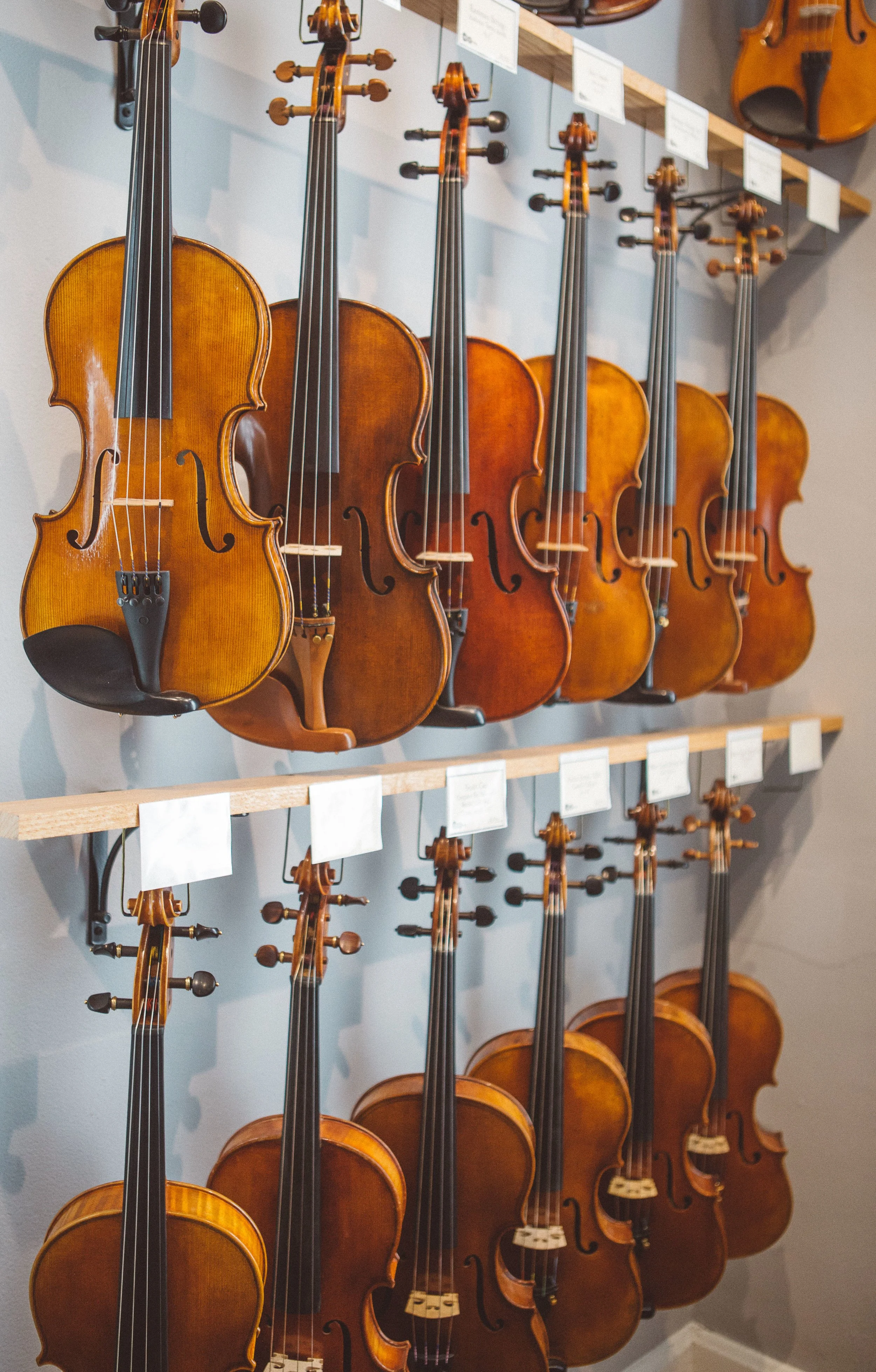CHOOSING THE RIGHT VIOLIN SIZE
Choosing the right violin size is a crucial step for anyone looking to begin playing this beautiful and elegant instrument. With a wide variety of sizes available, it’s important to find the right fit for your body type and playing style to ensure comfort, technique and, ultimately, musical success. Whether you are a beginner or a seasoned player, understanding the nuances of choosing the right violin size is essential. In this article, I’ll explain how to determine the correct size for you or your child, exploring the differences in sound quality between violin sizes and providing tips for taking care of your instrument.
What size violin is right for you?
hen choosing a violin, it’s important to pick the right size. The size of your violin will affect both your playing ability and overall comfort. A violin that’s too big or too small can result in playing difficulties and can even cause physical strain. So, what size violin is right for you? The best way to determine the right size is to measure your arm length, which I’ll cover in the next section. However, a general rule of thumb is that adults typically use a full-size violin while children use smaller sizes.
How to measure your arm length for the right size
Measuring your arm length is a crucial step in finding the right size violin. To do this, extend your arm straight out to your side and measure the distance from your neck to your wrist. When your arm is fully extended and perpendicular to your body, the tape measure should touch the base of your neck and your wrist bone. Once you have your arm length measurement, use it to find the corresponding violin size on a size chart. Violin sizes range from 1/16 of the full size to the full size. Keep in mind that different manufacturers may have slight variations in their sizing.
Differences between violin sizes
Smaller sizes are suitable for children while adult players use a full-size violin. Within each size category, there may be subtle differences in shape and dimension. Some of the key differences between violin sizes include:
· The overall length and weight of the instrument
· The size of the fingerboard and spacing between the strings
· The sound quality and projection of the instrument
It’s important to try out different sizes and models to find the one that’s right for you. A well-fitted violin will allow for comfortable playing and improved technique. Overall, understanding violin sizes is essential for choosing the right instrument. Take the time to measure your arm length, research different size options and try out different models. By doing so, you can ensure that you have the right instrument for your needs and skill level.
Children
➤ 1/16: for children 3-5 years old with an arm length of 33.5 cm (14-15 inches).
➤ 1/10: for children 4-6 years old and an arm length of 36 cm (15-16 inches).
➤ 1/8: for children 5-7 years old with an arm length of 38.5 cm (16-17 inches).
➤ 1/4: for children 6-8 years old with an arm length of 44 cm (17-18 inches).
➤ 1/2: for children 8-10 years old with an arm length of 48.5 cm (18-20 inches).
➤ 3/4: for children 10-12 years old and an arm length of 52 cm (20-22 inches).
➤ 4/4 (full size): for children over 12 years of age and an arm length of 54 cm (22 inches).
Adults
It is always a good idea to try different violin sizes before purchasing to make sure it fits your individual body and needs. While a violin may fit your arm length, it should also be comfortable and easy to play to avoid injury or discomfort when playing for long periods of time.
How do I measure my violin size?
Measuring the size of a violin with your arm is a common and convenient method used by many musicians, especially beginners. Here are the steps:
➤ Hold your left arm out in front of you with your palm facing up and your fingers together and extended.
➤ Place the violin under your chin with the scroll facing up and the body of the violin resting on your collarbone.
➤ Stretch your arm along the length of the violin until your hand reaches the end of the body. Your fingers should touch the end of the tailpiece.
➤ If the violin is the right size for you, the distance from the base of the neck (where it meets the body) to your wrist should be the length of your arm from the neck to the wrist. If the distance is shorter than your arm length, the violin may be too small; if it’s longer, it may be too large.




Playing with a violin of the wrong size
If a violin is too large or too small, it may cause discomfort or difficulty for the player and affect the quality of the sound that you produce . Therefore, I don’t recommend having a different size violin. However, if you still want to play with different sizes, here are some tips for taking care of a violin that is too big or too small:
➤ Adjust the chin rest: The chinrest can be adjusted to fit the player’s chin more comfortably. If the violin is too small, a higher chinrest can be added to help the player reach the chinrest more easily. If the violin is too large, a lower chinrest can be added to help the player reach the chinrest more comfortably.
➤ Use a shoulder rest: a shoulder rest can be used to support the violin and make playing easier. If the violin is too small, a shoulder rest can be used to raise the instrument and make it easier to play. If the violin is too large, a shoulder rest can be used to bridge the gap between the player’s shoulder and the instrument.
➤ Use a smaller or larger bow: if the violin is too small or too large, a smaller or larger bow can be used to compensate for the difference. A smaller bow can be used for a smaller violin, while a larger bow can be used for a larger violin.
➤ Have the violin adjusted by a professional: only do this if the violin is new enough to visit a professional violin maker to make all the adjustments to the instrument.
➤ Consider purchasing a new instrument: if the violin is significantly too big or too small, it may be worth considering purchasing a new instrument that is the correct size for the player. This can help ensure that the player is comfortable and able to play to the best of their ability.
What to look for when buying a beginner’s violin
When buying the first violin for a child, it is important to consider several factors to ensure maximum comfort and ease of playing. Firstly, consider the type of wood used to make the instrument; spruce is a popular choice for the top while maple is often used for the back and sides. A properly made violin should produce a clear and resonant sound. The bow is a crucial part of the instrument, and it’s important to choose a bow that is lightweight and easy to handle. A high-quality set of strings will also improve the sound and playability of the instrument. By following these guidelines, parents can help their child choose the right size violin and accessories to make learning the violin an enjoyable and comfortable experience.
Common adjustments to a new violin
A luthier may make several adjustments to a new violin to ensure that it is playable and sounds its best. Here are some common adjustments a luthier may make to a new violin:
➤ Adjusting the sound post: the sound post is a small wooden peg inside the violin that helps transmit vibrations from the top to the back of the instrument. A luthier can adjust the position and tension of the soundpost to optimize the sound and tone of the instrument.
➤ Adjusting the Bridge: the bridge is the small piece of wood that supports the strings and transmits vibrations to the body of the violin. A luthier can adjust the height and position of the bridge to optimize the sound and tone of the instrument and to ensure that the strings are properly spaced and aligned.
➤ Adjusting the fingerboard: the fingerboard is the flat wooden surface on the neck of the violin where the strings are pressed down to produce notes. A luthier can adjust the curvature and height of the fingerboard to ensure that the strings are properly spaced and that the player can easily reach each note.
➤ Adjusting the nut: the nut is a small piece of bone or plastic at the top of the fretboard that helps hold the strings in place. A luthier can adjust the height and spacing of the nut to ensure that the strings are properly spaced and aligned.
➤ Adjusting the tailpiece: the tailpiece is the small piece of wood or composite material that holds the strings in place at the bottom of the instrument. A luthier can adjust the position and tension of the tailpiece to optimize the sound and tone of the instrument.
➤ Adjusting the pegs: the pegs are the small wooden pins at the top of the instrument that are used to tune the strings. A luthier can adjust the fit and tension of the pegs to ensure that the strings are properly tuned and that the instrument stays in tune while played.
By making these adjustments, a luthier can ensure that a new violin is properly set up and optimized for sound and playability.
Frequently Asked Questions
-
Extend the left arm so it is parallel to the floor, then measure the distance from the base of the neck to the wrist.
-
It’s recommended to choose the smaller size violin if your child is between two different sizes, as it will be easier to hold and play.
-
Yes, choosing the right size violin is important for proper playing position, posture, and sound quality.
-
You can determine if your violin is the correct size by measuring the distance between the scroll and the end of the violin. It should be the same as the measurement of your arm length.
-
Common sizes for violins include full size, 3/4 size, 1/2 size, 1/4 size, 1/8 size, and 1/16 size.
-
It’s recommended to try different sizes and see which is the most comfortable for you. You can also consult with a professional or a music teacher for guidance.
-
Yes, the size of the violin bow should be proportionate to the size of the violin for proper technique and sound quality.
Read more articles
Quick video tips
““It is always advisable to try different violin sizes before purchasing to make sure it fits your individual body and needs.””




























